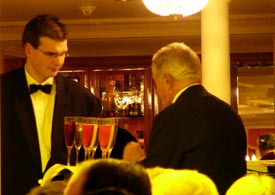MS Casanova

ABOVE: A waiter serves drinks at the captain's
welcome reception.
Audience and ambience
Like other Peter Deilmann river vessels, Casanova serves
a multinational audience. This makes it different from its leading competitors
on the European river-cruising circuit, which operate separate vessels for the
U.S. and Canadian market (Viking) or cater only to North American travelers
(Avalon Waterways, Uniworld, Vantage, etc.).
The bulk of Deilmann's guests come from German-speaking
countries, but a substantial minority are from the U.S., Canada, and Britain. On
our cruise, about a third of the passengers were American or Canadian, with one
British couple on board. Most of our fellow guests were in their 60s or older (a
fairly typical age range for European river cruises).
The ship's ambience has a strong German flavor, but don't go
looking for stereotypes from yesteryear: The waiters, stewardesses, and
reception staff are more friendly than formal, and the dress code on most
evenings is "smart casual." You'll notice the Teutonic influence mostly when you
turn on the TV--where German channels predominate--or if you request water in
the restaurant, when you'll be asked if you want bottled mineral water or
American-style ice water. (After the first meal or two, your beverage stewardess
will remember your preferences.)
All ship's announcements are in both German and
English, and separate versions of the daily newsletter are published for
Deutsch- and English-speaking guests.
Overall, Casanova and Peter Deilmann Cruises offer a more
cosmopolitan atmosphere than you'd find on a vessel that caters primarily to
U.S. and Canadian travelers. With Deilmann, you feel that you're in Europe when
you're aboard the ship, not just when you go ashore. Whether that's good or bad
depends on your tastes and whether you prefer mingling with the locals or
sticking with fellow foreigners.
Next page:
Staterooms on the Casanova
|